Personal development planning for engineering
Use 'Print preview' to check the number of pages and printer settings.
Print functionality varies between browsers.
Printable page generated Friday, 26 April 2024, 10:29 AM
Personal development planning for engineering
Introduction
This course is focused on your career as an engineer. It provides an opportunity to interrogate and scrutinise your career plans. This might be the first time you have really considered your future career as an engineer; although, particularly if you are already working in engineering, it won't be new at all. Even if you do already have strong career plans, don't think that these plans can't be reflected and improved upon. It might not be your first time considering and planning your career as an engineer, but it might be the first time you can do it without your boss or line manager peering over your shoulder.

In general, personal development planning, or PDP, encompasses the importance of recording, reflection and planning in helping you to manage your learning and development in an efficient and effective way. In the same vein, career development planning focuses on the principles and processes that are involved in effective career development, and examines the benefits of developing and/or updating a career plan during your studies and beyond. If you have already gone through the development planning process, you might have a current plan for development. If so, view this as an opportunity to review your current plans independently of people who might have a conflict of interest with regard to your career trajectory. It's always a good idea to periodically review whatever plans you have made.
As an introduction to career planning and thinking about your career in general, listen to Audio 1, which discusses the benefits of PDP for a career in engineering and considers how you might go about gathering evidence. Remember to make notes as and when you feel it is necessary.
Transcript: Audio 1 PDP and career planning
The activities you are asked to do here will require significant thought, so I would expect you to take approximately 10−12 hours to complete the course (including reading, contemplating and completing the activities). It is difficult to give guidelines for each individual activity because you may or may not have visited the topic in the past. Therefore, I suggest you keep in mind that there are a total of 12 activities and I expect you to take no more than approximately 12 hours to complete the entire course. Some activities require thought and reflection and might take 1.5 hours, while others simply require collection of information and might only take 10 minutes. You might want to spread your study over several days to give you time to reflect on your responses.
While working through this course you will need to log your progress. You will notice that on many occasions you are prompted to make an entry into your 'learning log'. This can take many forms. You can use a word processor or computer note pad or you can use an online journal or organiser, it could even take the form of a book in which you make hand written notes. However, for the purposes of creating evidence of completing this course, I recommend that you use some sort of electronic note-taking software (this could be Microsoft Word), that is capable of saving a document containing all your inputs when you have completed the different tasks.
This OpenLearn course is an adapted extract from the Open University course T176 Engineering: professions, practice and skills 1.
Learning outcomes
After studying this course, you should be able to:
provide evidence of critical assessment of personal career development
provide evidence of a career development plan linked to the requirements of professional engineering institutions, with a clear strategy for achieving personal goals
demonstrate an awareness of factors that might help or hinder personal development towards becoming a professional engineer
1 Career development planning
1.1 PDP and career development
To start you thinking more deeply about what personal development planning actually means, and why it is useful to you as a student and as an engineering professional, here are some statements about its role in (engineering) education.
PDP is a structured and supported process undertaken by a learner to reflect upon their own learning, performance and/or achievement and to plan for their personal, educational and career development. It is an inclusive process, open to all learners, in all HE provision settings, and at all levels.
The primary objective for PDP is to improve the capacity of individuals to understand what and how they are learning, and to review, plan and take responsibility for their own learning. This will help students:
- become more effective, independent and confident self-directed learners
- understand how they are learning and relate their learning to a wider context
- improve their general skills for study and career management
- articulate personal goals and evaluate progress towards their achievement
- develop a positive attitude to learning throughout life.
The most important ideas to take from the statements presented above are those of responsibility, reflection and undergoing a continuous process. But in addition, and quite significantly because of the theme of this course, career development is also referred to as a key part of personal development planning. Thus we can apply each of the three key ideas of PDP in general to career development planning specifically, as follows:
- A willingness to take responsibility for personal development planning is something that more and more employers are expecting from their employees.
- Reflection is one of the key cognitive skills you need to create evidence for in this course, and thinking critically and thinking for a purpose are two key aspects of reflection. For example, later in this course you will be asked to think critically about your strengths and weaknesses when mapping your skills and competences against the demands of relevant occupational standards and frameworks. This involves thinking for a purpose – in order to identify skills gaps and potential development needs.
- The notion that the cycle of reflection, planning and action must be a continuous one is also crucial and links the process to lifelong learning and employability.
Now take a few minutes here to listen to the interview with Professor John Bouchard. John comments on how, at each stage of his career, he stepped back and thought about what he was enjoying and how he would use this to determine his next career move. If he hadn't taken the time to think about what he enjoyed and what he was good at, he probably wouldn't be doing what he is now.
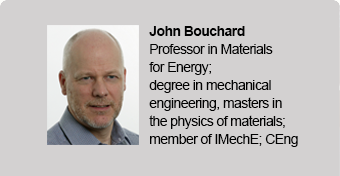
Transcript: Audio 2 Interview with Professor John Bouchard
1.2 The benefits of career development planning
Career development planning is a process that involves taking stock of where you are personally, academically and professionally, deciding where you want to be, and working out the best means of getting there. It may be helpful to think of career development planning as analogous to planning the route for a journey (Figure 2). You need to know your starting point, your end point and the places you wish to visit along the way. As with any journey, you need to work out the most efficient mode of transport given the resources at your disposal. Furthermore, while you are travelling the route, you can't just travel on 'autopilot'; you need to check periodically that you are still on course to reach your destination, and be prepared to overcome any obstacles you meet on the way. This is sometimes referred to as reflection-in-action: put simply, being aware of what you are doing while you're doing it.

Figure 2 is a cartoon that depicts a woman attaching post-it notes, images and leaflets to a map pinned to a wall. The map shows a planned route with notes about various destinations along the way.
For the moment, just keep hold of the notion that career development, as with PDP in general, is best carried out as a continuous process of recording, reflection, planning, action and monitoring. The following activity will help you with this.
Activity 1
Aim of this activity:
- to discover the resources available to you as an OU student and to get to grips with the cyclic process of career planning.
Visit the following page of the OU's Careers Advisory Service website. Take 10 minutes or so to look over the content and to watch the short video clips. Then explore some of the links and make a table in your learning log of the services and resources available on the careers website, detailing what each resource provides and how you think it might be useful for your future career development.
By now I hope it is clear that applying the techniques underpinning PDP to your career can help you to get where you want to go. The next activity will help you to explore the benefits of career development planning in more depth.
Activity 2
Aim of this activity:
- to review your career development experiences.
In your learning log, give up to four examples of previous career development activities you have undertaken. These might include work-related appraisals, discussions you have had with mentors and colleagues, or even just personal planning you have done off your own back. Comment on how useful each activity has been in your career development so far.
Comment
You may have struggled with this exercise. Perhaps you don't feel that the activities in which you have previously taken part were of any help to your career at all. But often, when people have negative experiences of PDP it's because it wasn't made clear to them what the benefits are. Maybe the focus appeared to be on keeping the employer happy rather than on the employee's own potential for improvement and fulfilment. Indeed, it is important to note that you are being asked to engage in career development planning for a particular purpose within the context of this course – it doesn't need to fit with your current job or role.
I hope you are beginning to see that for PDP to be a success, the focus must be on you: your abilities, your goals, and how you can achieve what you want to achieve – both as a learner and as an engineer. This is the topic I will turn to now.
1.3 Managing your career development
With a career development plan, you'll be able to be active in pursuing your personal goals rather than being a passive recipient of training and development deemed appropriate by others. After all, you're the one in the best position to know what kind of development you need. Good career planning starts with finding the answers to three basic questions:
- Where am I now?
- Where do I want to go?
- How will I get there?
To help you think about how you might go about answering these questions, I would like you to listen to the first part of an interview with Chi Onwurah, an engineer who became MP for Newcastle Central. Before you listen to the in-depth interview, watch Video 1, which will give you an introduction to Chi and her background through her conversation with Benjamin Zephaniah.
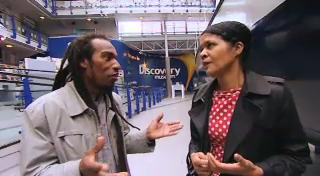
Transcript: Video 1 Chi Onwurah talks to Benjamin Zephaniah
The video begins with shots of Benjamin Zephaniah walking through Newcastle. Some of Newcastle's bridges and buildings are visible in the background.
Benjamin meets up with Chi Onwurah and they walk into the Discovery Museum. They walk around the main atrium and look at the ship Turbinia. Close-ups of parts of the ship are shown interspersed with shots of Chi and Benjamin talking.
Chi and Benjamin then walk into one of the side rooms off the main atrium and continue their conversation. Models, photos and pieces of machinery are visible in the room.
The video ends with further shots of bridges in Newcastle.
Now listen to Audio 3, which is the first part of the interview with Chi Onwurah.
Transcript: Audio 3 Interview with Chi Onwurah (part one)
Chi gives some sound advice in this audio:
- Decide what career path you want to follow.
- Identify the skills you have, and any deficiencies.
- Plan a systematic approach to your development.
- Keep records and a logbook.
- Have a CV that tells the story of your skills.
Now use the next activity to tackle Chi's first point – that is, to decide on, or at least put to paper some thoughts about, a career path you want to follow. I assume by the fact you are engaging in this course that you want to be an engineer, so a little bit more detail is needed here.
Activity 3
Aim of this activity:
- to put on 'paper' where you want to be.
In your learning log, make that important statement: where you want to be! Don't worry if you are not fully decided – at the moment you can be quite broad and just state the area of engineering you are interested in. On the other hand, if you are already working in your chosen field or have a lot of previous career experience, you may want to be more specific about your goals. There is no correct answer to this activity, as long as your response is personal to you.
Then comment on why you have chosen that particular area of engineering or specific goal.
1.4 Summary
In this section you've been introduced to the principles and processes behind career development planning, and explored the benefits to be gained from such planning. Hopefully it is now becoming clear why PDP is important to you in today's labour market.
2 Evaluating your abilities ('Where am I now?')
This section will focus on the second point that Chi made in Audio 3: identifying the skills you have now. Evaluating your abilities is concerned with helping you to take stock of your current position by:
- identifying the range of knowledge, skills and experience you possess
- exploring your strengths and weaknesses in relation to your current role
- examining the opportunities and threats facing you at present.
To do this, start by identifying all the sources that you can use – these can be quite varied. For instance, you might consider:
- your most recent work appraisal
- academic or professional qualification transcripts
- assignment feedback
- client or customer feedback.
A key part of this is collecting evidence from a variety of sources so that you can see how different people or organisations rate your strengths and weaknesses. This can be useful when it comes to recognising either unrealistically high or unnecessarily low estimations of your own abilities. You should also consider sources from outside your professional and academic circles. For instance:
- any sporting activities you take part in
- societies or clubs.
This is an example of how to apply a holistic approach to career development (Figure 3).
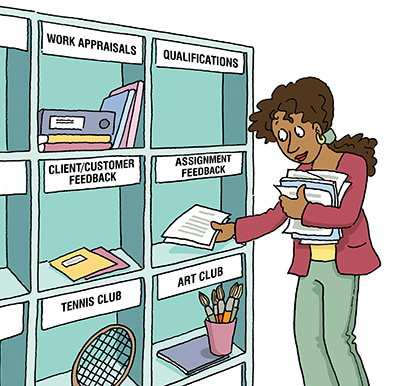
Figure 3 is a cartoon that depicts six shelving compartments or pigeonholes. These are labelled 'Work Appraisals', 'Qualifications', 'Client/Customer Feedback', 'Assignment Feedback', 'Tennis Club' and 'Art Club'. A woman is organising papers and folders into the compartments.
It's all well and good for you to go away and identify possible sources now, but this won't be much use in a month or so when you have forgotten all the details. So the next activity will start you off on the process of developing a portfolio of evidence – initially regarding where you are now, but there is nothing stopping you from keeping this up to date in the future and outside the confines of this course.
Activity 4
Aim of this activity:
- to start a record of where you have information and evidence stored for easy future reference.
Table 1 below is an example of some sources of evidence. Give a few examples of sources of evidence you could draw on. It will be useful to update this in the future as your studies and your career progress.
| Description of information source | Kind of information | Location | Usefulness |
|---|---|---|---|
| Last year's performance appraisal | Covers work performance and professional development needs | My personal file at work | Contains useful information on skills gaps |
| Most recent CV | Jobs, education and training, skills, abilities and interests | On my home computer | Good source, but needs updating |
| Feedback from most recent study assessment (i.e. tutor comments on coursework) | Comments on performance and study skills | In my OU study folder | Identifies some key strengths and weaknesses |
| Opinions of friends, family and colleagues | Comments on my list of strengths and weaknesses | Informal checklist | Very subjective, but may provide food for thought |
2.1 Your skills and competences
You will now have the chance to explore your range of skills and competences with reference to a specific professional engineering standard. However, before you get started on this I would like you to listen to the second part of the interview with Chi Onwurah (Audio 4), in which she discusses what she believes makes a good engineer.
Transcript: Audio 4 Interview with Chi Onwurah (part two)
Chi again makes some very useful points, but a lot of them are purely anecdotal. This is often a problem – you know where you want to be, but who do you trust with regard to how you get there? One invaluable source of information is any occupational or professional standard that has been agreed for your intended field. When it comes to engineering, the specification for the educational and professional requirements of UK engineers is laid out in the United Kingdom Standard for Professional Engineering Competence, widely known as UK-SPEC. This standard is the responsibility of the Engineering Council.
Occupational or professional standards such as UK-SPEC are detailed written statements about the level and range of skills and knowledge that you are expected to demonstrate as you carry out your work. They prescribe acceptable levels of performance and, if you work to such standards, you can certainly use them as a benchmark for your skills, knowledge and experience. Benchmarking, in this context, means comparing the skills, knowledge and experience you currently possess with sets of standards that are relevant to your area of work. You can then begin to assess how 'competent' you are (where competence simply refers to your ability to carry out tasks to the required standard).
UK-SPEC was drawn up by engineering employers, educators and professional engineering institutions. It has been in effect since 2004, when it replaced a previous Engineering Council specification called SARTOR (standing for 'Standards and Routes to Registration'). If, at any point in the past, you worked towards registration under SARTOR then an application will now be considered under UK-SPEC, which does not impose any extra requirements on applicants.
The next activity is intended to start you thinking about how your skills and competences compare to those required by UK-SPEC. This is a useful activity even if you don't intend to seek professional membership, or for that matter even if you already have professional membership, because the competences will still be relevant to developing any career in engineering.
Activity 5
Aim of this activity:
- to examine where you fit within the context of UK-SPEC.
Download a copy of UK-SPEC from the Engineering Council website.
Before you can start benchmarking, you need to decide which of the three grades of professional membership you wish to use for your assessment. If you have already qualified for one grade, you might like to look at a different one. To that end, read the summary statement at the beginning of the description for each grade of membership: Engineering Technician (EngTech), Incorporated Engineer (IEng) and Chartered Engineer (CEng). Then look at the section headed 'Education' near the end of the description for each grade. Select the grade that best reflects the standard towards which you feel you are currently working.
If you are already working in engineering with a fair bit of leadership experience, you may well decide to go for CEng; however, in many cases you will be best off choosing EngTech or IEng.
Once you have chosen an appropriate grade, look at the five 'Competence and Commitment' standards under the grade description (labelled A to E). Try to think about how you might demonstrate that you have achieved each competence or commitment through a specific activity. Consider in particular any areas that you don't yet meet, and think about how this might be addressed in the future. At this stage of your education, don't be surprised if you fall short on a lot of the aspects. Record the results of your benchmarking using the following headings in your learning log.
- Chosen professional engineering grade
- My justification for choosing this grade
- After comparing what I can do with UK-SPEC, are there any key areas that I seem to be falling short in? (Refer to specific 'Competence and Commitment' standards given in the document.)
- How can I address these gaps in knowledge, skills and experience? (Use the examples given in UK-SPEC for guidance and consider referencing future study you intend to undertake − perhaps consider some OU courses that might be of benefit.)
2.2 What you enjoy doing
Another aspect of finding out about yourself is to try and identify the kinds of things that you enjoy and are good at. One way of approaching this task is to identify and reflect upon your successes at work or outside work by completing a list of positive statements. However, in the spirit of reflective practice and learning from all experience there is also much to be gained from completing a companion list of negative statements.
Activity 6
Aim of this activity:
- to take stock of what you enjoy and what you don't enjoy.
Complete at least three positives and three negatives from the following statements. Try and include why you feel that way about the particular activity or event. An example might be:
I did well and am proud of my recent attempt at wallpapering. I hadn't attempted it before and was surprised at how well it turned out.
As you can see from this example, you don't need to limit yourself to work-related statements. Try and use a broad spread from across your day-to-day life.
Positive experience statements:
Negative experience statements:
For the purpose of evidence collection, take a screen shot of your complete statements and paste it into your learning log.
Don't be disheartened by the negative statements. You may even notice that you've already dealt with some of the experiences, and that reviewing them can be more positive and enjoyable.
Activity 7
Aim of this activity:
- to reflect on your answers to Activity 6.
Go back over your responses to Activity 6 and analyse your statements in a learning log post. Do you notice any trends in the types of experiences that were positive and those that were negative? What do you think these experiences can tell you about yourself and your abilities?
2.3 Your opportunities and threats
As you have worked through this section on evaluating your abilities, you will have collected a lot of information relating to your strengths and weaknesses and considered the opportunities and threats facing you. You will now see how you can summarise and analyse this information.
Figure 4 shows a matrix designed to help you summarise and analyse your strengths, weaknesses, opportunities and threats (often referred to by the acronym SWOT). The basic framework consists of four fields with those names, into which you list any factors that are appropriate to the subject being analysed – in this case your career development.
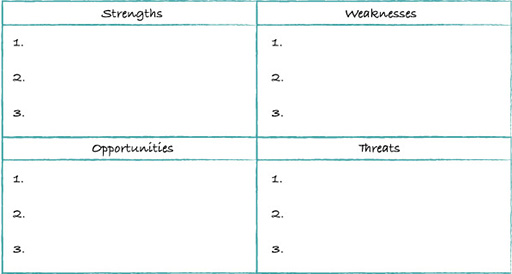
Figure 4 shows a two-by-two grid. The top left box is labelled 'Strengths', the top right box is labelled 'Weaknesses', the bottom left box is labelled 'Opportunities' and the bottom right box is labelled 'Threats'. Each box contains a list numbered 1 to 3, but the entries have yet to be filled in.
SWOT analysis can be used for a wide range of applications. However, for the purposes of this course, the SWOT matrix will be used to help you analyse your strengths and weaknesses in relation to any opportunities and threats that may help or hinder your career development. Once you've done that, you can plan to build on your strengths and deal with your weaknesses, which will put you in a better position to take advantage of any opportunities and counter any threats.
To carry out a personal SWOT analysis, you need to complete the matrix in terms of the following.
- Strengths: What do you do well? What do other people see as your strengths? What are your skills, values and interests?
- Weaknesses: What areas need development? What should you avoid?
- Opportunities: What possibilities are open to you? What resources do you have? Who can help you?
- Threats: What might cause you difficulties? What responsibilities do you have? What might restrict you?
This analysis will help you to focus on the main issues you need to consider when deciding what your long- and short-term goals should be. Explore what you do well, the areas you need to work on, the possibilities that are open to you and the things that might cause difficulties. In particular, you need to be absolutely honest about your weaknesses because you can take steps to develop those areas. It's a good idea to keep things simple at this stage – I've included my own example as Figure 5.
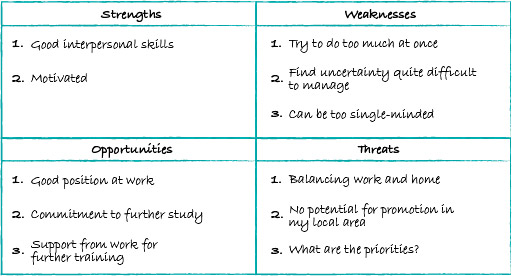
Figure 5 shows a filled-in version of the grid from Figure 4. The 'Strengths' box contains two points: 'Good interpersonal skills' and 'Motivated'. The 'Weaknesses' box contains three points: 'Try to do too much at once', 'Find uncertainty quite difficult to manage' and 'Can be too single-minded'. The 'Opportunities' box contains three points: 'Good position at work', 'Commitment to further study' and 'Support from work for further training'. The 'Threats' box contains three points: 'Balancing work and home', 'No potential for promotion in my local area' and 'What are the priorities?'.
Activity 8
Aim of this activity:
- to conduct a personal SWOT analysis.
Insert a blank grid into your learning log and complete your own SWOT analysis. Once you've used your analysis to identify what is feasible, you can start to prioritise and decide what you want to achieve first. You can then link this to your goals, which we'll cover in the next section.
2.4 Summary
In this section you have sought to identify and benchmark your current skills, knowledge and experience, explored your strengths and weaknesses, and looked at the opportunities and threats you see around you. You are now ready to move confidently into the future!
3 Identifying your career goals ('Where do I want to go and how will I get there?')
In the previous section you spent a lot of time taking stock of your current situation, i.e. where you are now. In this section you'll receive advice and guidance designed to help you identify your future career goals, i.e. where you want to go. You already made a start at answering this question in Activity 3, in which you wrote down where you wanted to get to as an engineer. However, now it's time to broaden this focus to take in how your engineering career relates to other aspects of your life. This will allow you to come up with some more specific career goals, as well as other long- and short-term personal goals that are related in some way to your career.
In order to identify these goals, you have to consider carefully what you want out of life and work – and where the balance between the two lies for you. This kind of judgement is a snapshot that will change as your circumstances change – a fact that highlights the need to revisit and review your personal development plan on a regular basis. Below is an example of a completed wish list that identifies a set of my long- and short-term goals at a particular stage in my life.
What would I like to achieve in the long term?
- Financial security for my family
- An interesting career within a stimulating working environment
- Be a senior manager by 45 or involved in my own business
- My children happily settled
- Time to enjoy life.
What would I like to achieve in the short term?
- A degree
- An MEng
- Professional registration
- Promotion into management.
Even if you have already planned a career path, it is still worth asking yourself these kinds of questions. The next activity will help you to define more clearly what it is that you really want.
Activity 9
Aim of this activity:
- to clarify in your mind what you really want in the long and short term.
Referring to the example above, complete your own wish list in your learning log that identifies your long- and short-term goals. You may want to take your answer to Activity 3 as a starting point.
3.1 Your values
Your values obviously have an important influence on what it is that you really want out of life and work. Again, your values will change as your circumstances change, so you need to reassess what's important to you on a regular basis.
To me, stating my values feels a little philosophical, but in essence, what I mean by values is those things that are important to you. For example, Coomber et al. set out a list of six values that they feel people should consider when thinking about a change of career (Figure 6):
- Benevolence Doing things for others
- Conformity Being accepted, doing what's socially correct
- Independence Making decisions, getting your own way
- Leadership Being in charge, having power and authority
- Recognition Being highly regarded and admired, having status, being important
- Support Being treated with understanding and consideration
(Coomber et al., 2002)
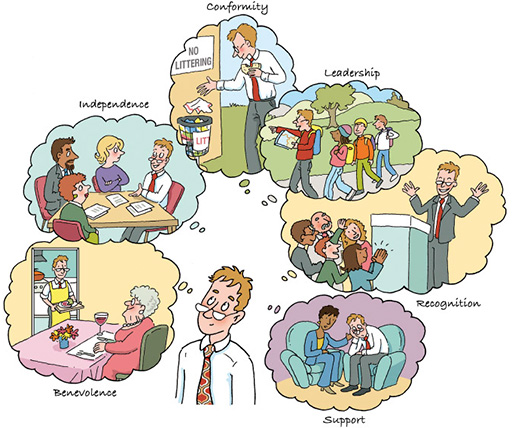
Figure 6 is a cartoon showing a man thinking. Six thought bubbles are coming out of his head, one for each of the values listed above, as follows:
- Benevolence is represented by the man cooking a meal for an elderly person.
- Independence is represented by the man making a decision in a meeting.
- Conformity is represented by the man throwing a food wrapper in a litter bin.
- Leadership is represented by the man with a map at the head of a walking party.
- Recognition is represented by the man standing on a podium with people smiling and clapping below.
- Support is represented by the man looking worried while someone else comforts him.
I don't expect you to relate to all the above values or consider them all to be important. Nor is the list exhaustive, by any means – you might feel that honesty, time to spend with your family, or particular moral or religious beliefs are most important to you, for example. However, the list is a good starting point from which to create your own personal goal statement.
Your mission statement should provide you with a focus around which you can begin to plan your career development goals. Now is a good time to do this, because otherwise these kind of values might be forgotten when you are planning your career and only become apparent once you are fully committed to an avenue. Of course, your values aren't mutually exclusive – although some will probably be more important to you than others at the present time – so you can combine several of them to come up with your statement. And remember, the things that are important to you in your career may not be the same things that you value most outside work.
So what does a mission statement look like? Here are some example statements to get you thinking.
To undertake world-class research in my field and disseminate my research and knowledge in an open and free manner.
To work in the area of engineering while rigorously maintaining my values with regard to environmental sustainability.
To incorporate my love of aviation into my working life.
To work in a flexible institution where I will be able to take time off in the week in exchange for working at the weekend.
To lead a team of people.
To make changes that improve people's lives, even if only a little bit.
Remember, your mission statement doesn't have to consist of a single sentence – you can put together two or three of these kind of statements to construct your overall statement.
Activity 10
Aim of this activity:
- to propose your personal mission statement.
In a learning log post, write your own personal mission statement. This shouldn't be more than two or three paragraphs. Try to include something you highlighted in Section 2 as being a strength of yours, as well as some of your personal values.
3.2 Identifying career opportunities
Identifying career opportunities that are realistic in terms of what you have to offer, and that will help you to meet your aspirations, is obviously a key aspect of managing your career.
Activity 11
Aim of this activity:
- to make yourself aware of the facilities for finding career opportunities.
At this point I would like you to go back to the OU's Careers Advisory Service website. Browse through the site, and add some resources for finding career opportunities to the list of useful career resources you created in Activity 1.
3.3 Your career action plans
By this point, you've looked at where you are now and where you want to go. Now you are in a stronger position to develop or update your career development plan, which details how you aim to get there. This will involve organising and summarising much of the information that you have gathered during your work on this course into a set of action plans. Remember that you are being asked to engage in career development planning for a particular purpose within the context of this course – it doesn't need to fit with your current job or role.
Sorting out how you can go about achieving your career and personal goals may appear daunting. However, a good way to approach a large task is to devise an action plan that breaks it down into smaller chunks that are easier to handle – there's an example in Figure 7. If you take the goals you identified in Activity 9, you should be able to produce an action plan for each one. There are four factors to consider when drawing up your action plan:
- what you need to do
- how you are going to take action
- resources that could help you (e.g. finance, information, friends)
- when these resources will be available to you.
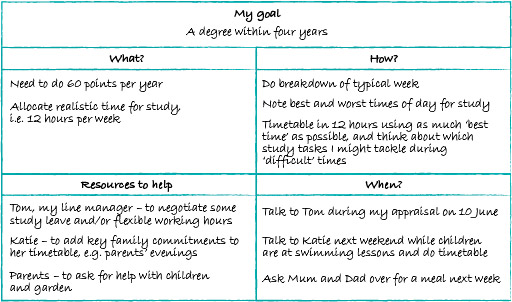
Figure 7 is a table entitled 'My goal: A degree within four years'. Below the title is a two-by-two grid as follows.
The top left box is labelled 'What?'. It contains two items: 'Need to do 60 points per year' and 'Allocate realistic time for study, i.e. 12 hours per week'.
The top right box is labelled 'How?'. It contains three items: 'Do breakdown of typical week', 'Note best and worst times of day for study' and 'Timetable in 12 hours using as much best time as possible, and think about which study tasks I might tackle during difficult times'.
The bottom left box is labelled 'Resources to help'. It contains three items: 'Tom, my line manager – to negotiate some study leave and/or flexible working hours', 'Katie – to add key family commitments to her timetable, e.g. parents' evenings' and 'Parents – to ask for help with children and garden'.
The bottom right box is labelled 'When?'. It contains three items: 'Talk to Tom during my appraisal on 10 June', 'Talk to Katie next weekend while children are at swimming lessons and do timetable' and 'Ask Mum and Dad over for a meal next week'.
Your action plan should also relate to the SWOT analysis you did in Activity 8 and the mission statement you put together in Activity 10. Try to view your action plans as the end product of all the recording, reviewing and reflection you've done throughout the career development process. But remember, in another sense the action plans you produce are simply a link in the chain; they have to be reviewed and, depending on the progress you've made and any changes in your circumstances, the action plans may have to change to accommodate revised aptitudes, interests, goals and values. For the purpose of this course, we have used the generic term of learning log; however, in the future, it doesn't really matter how you record and store the information, evidence and reflection accumulated in the career development planning process – as long as it is orderly and easily accessible. The important thing is to make sure that you go through each stage of the process on a regular basis.
In the final activity of this course, you will develop or update your career development plan.
Activity 12
Aim of this activity:
- to produce detailed career action plans.
Using the example in Figure 7 as a basis, create an action plan for at least one of the goals you identified in Activity 9.
Conclusion
In this course you've identified your career goals, looked at your values and explored sources of information, advice and guidance for identifying career opportunities. You've then used all this information to create a career development plan.
You should now take your learning log and save your posts into a single file and keep this as the evidence that you have studied and engaged with this course.
References
Acknowledgements
Except for third party materials and otherwise stated (see terms and conditions), this content is made available under a Creative Commons Attribution-NonCommercial-ShareAlike 4.0 Licence.
Cover image: Eneas De Troya in Flickr made available under Creative Commons Attribution-NonCommercial-ShareAlike 2.0 Licence.
The material acknowledged below is Proprietary and used under licence (not subject to Creative Commons Licence). Grateful acknowledgement is made to the following sources for permission to reproduce material in this free course:
Every effort has been made to contact copyright owners. If any have been inadvertently overlooked, the publishers will be pleased to make the necessary arrangements at the first opportunity.
Don't miss out
If reading this text has inspired you to learn more, you may be interested in joining the millions of people who discover our free learning resources and qualifications by visiting The Open University – www.open.edu/ openlearn/ free-courses.
Copyright © 2016 The Open University